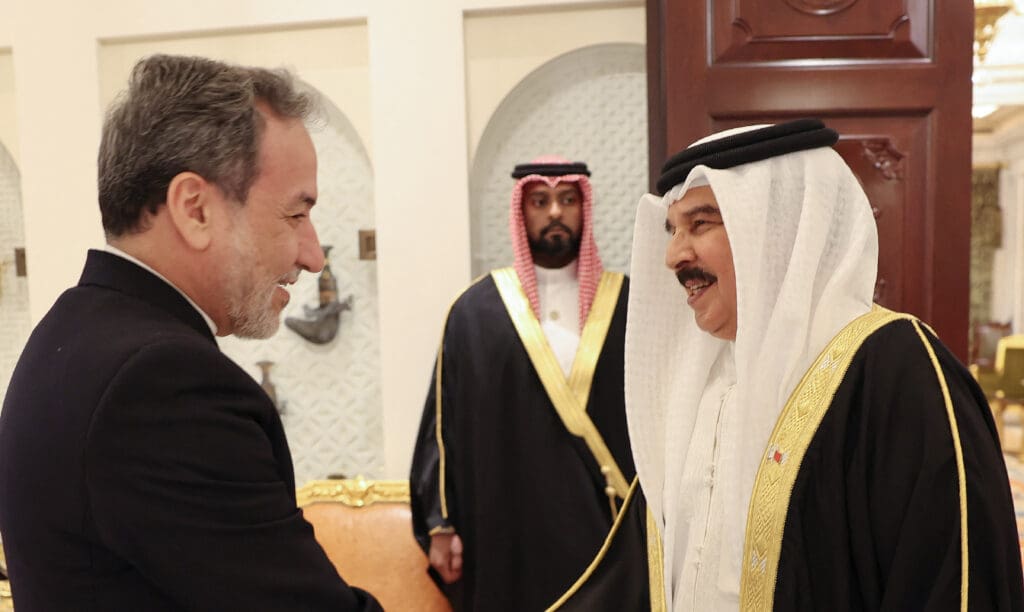On October 21, Iran’s Foreign Minister Abbas Araghchi visited Manama and met with King Hamad bin Isa Al Khalifa, marking a significant turning point in Iran-Bahrain relations that have been severed since 2016. This visit—the first by an Iranian foreign minister to Bahrain since 2010—took place amid an escalating military confrontation between Iran and Israel. While Bahrain and Iran have yet to restore full diplomatic and economic ties, Araghchi’s visit is a step forward in a process that has gathered pace over the past five months. Yet the path to normalization remains fraught with deep structural barriers rooted in historical grievances, geopolitical complexities and enduring mutual suspicions.
Bahrain’s recent diplomatic overtures toward Iran were preceded by a shift in the kingdom’s approach to internal dissent, particularly in the relationship with its majority Shi’a population. In April, Bahrain released thousands of Shi’a political prisoners in a move to ease domestic tensions. While ostensibly unlinked, this was followed by a series of significant diplomatic gestures towards Iran, beginning with King Hamad sending a message of condolence to Iran’s Supreme Leader Ayatollah Ali Khamenei after the death of Iranian President Ebrahim Raisi on May 20. Days later, Bahrain’s Foreign Minister Abdullatif bin Rashid al-Zayani attended Raisi’s funeral in Tehran.
In June, Bahrain sent a message through Russia expressing its desire to re-establish ties with Iran, which King Hamad reiterated during his meeting with Chinese Premier Li Qiang in Beijing. By June 23, Bahrain and Iran had agreed to initiate bilateral talks, with al-Zayani traveling to Tehran to explore the possibility of resuming full diplomatic relations. King Hamad also congratulated Iran’s newly elected president, Masoud Pezeshkian, in July, after which al-Zayani attended Pezeshkian’s inauguration. The summer months saw continued high-level exchanges, including phone calls and meetings at international forums like the UN General Assembly and the Asia Cooperation Dialogue summit in Doha. These diplomatic breakthroughs are significant, but they represent only the beginning of what is likely to be a long and difficult journey toward normalization.
Fault Lines
The core obstacles to re-establishing ties lie in the complex and troubled history between the two countries. Since the 1960s, Iran’s territorial claims on Bahrain have created an enduring sense of distrust. While Iran eventually acknowledged Bahrain’s independence, accepting the results of a UN survey in 1971, and the two countries signed a continental shelf agreement, tensions remained. The situation worsened after the 1979 Iranian Revolution and the failed 1981 coup attempt in Bahrain, which was blamed on Tehran-linked actors. These events cemented Bahrain’s view of Iran as a destabilizing force in the region and an existential threat to the ruling family.
In the early 2000s, there was a brief moment of de-escalation, notably during Iranian President Mohammad Khatami’s visit to Manama in 2003 and discussions of a potential natural gas pipeline running from Iran to Bahrain. However, these efforts were overshadowed by Bahrain’s growing alignment with the United States, especially following the U.S. military’s expanded presence in Bahrain after 2001. Indeed, the presence of the U.S. navy’s Fifth Fleet in Bahrain became a significant point of contention for Iran.
By 2007, relations deteriorated further when the editor of Iran’s Keyhan newspaper, an advisor to the supreme leader, provocatively referred to Bahrain as a “province” of Iran. The editorial claimed that “the principal demand of the Bahraini people today is to return this province, which was separated from Iran, to its mother, Islamic Iran”—an unsubstantiated claim that fueled a diplomatic crisis. Despite efforts by Iran at the time to reassure Bahrain of its respect for sovereignty—including a trip by President Mahmoud Ahmadinejad to Manama and his foreign minister’s participation in the 2009 and 2010 Manama Dialogue summits—these episodes reinforced Bahrain’s perception of Iran as a threat.
The Arab Uprisings in 2011 further strained relations. Bahrain’s majority Shi’a population led widespread protests against the ruling monarchy, and the government quickly accused Iran of supporting the unrest. Although the Bahrain Independent Commission of Inquiry found no direct evidence of Iranian involvement, Tehran’s open support for Bahraini opposition figures solidified Manama’s suspicions. Since then, Bahrain’s leaders have viewed Iran as a persistent internal threat, even though Bahrain’s Shi’a political opposition has distanced itself from Tehran, and most Shi’a in Bahrain do not adhere to the Velayat-e Faqih—the theo-political ideology underpinning the Iranian state—or follow Ali Khamenei as a religious leader.
Bahrain’s geopolitical alignments also present significant hurdles to any meaningful rapprochement with Iran. Bahrain’s close partnerships with the U.S., Saudi Arabia, and the United Arab Emirates largely dictate the contours of its foreign policy toward Tehran. Bahrain’s participation in the Abraham Accords in 2020, which normalized relations with Israel, is particularly problematic from Iran’s perspective. Bahrain’s decision to align with the U.S.-Israel axis, its involvement in a U.S.-led military coalition against the Iran-backed Houthi forces in Yemen, and its 2022 security cooperation agreement with Israel underscore its strategic priorities.
These developments have solidified Bahrain’s role in regional security alignments designed to counter Iran. Tehran, in turn, views Bahrain’s close security ties with Israel as a direct threat. The talks in Manama on October 21 were closely tied to Iran’s efforts to manage the fallout from its missile attacks earlier in the month, which have since provoked Israeli retaliation. While Bahrain has become a significant military partner for Israel, it is unlikely that Manama would allow U.S. or Israeli forces to use Bahraini territory for attacks against Iran.
Bridging the Gulf
Despite these substantial challenges, there are areas where cooperation between Iran and Bahrain could bear fruit. One of the most promising sectors is energy. Bahrain’s growing need for natural gas, coupled with Iran’s abundant reserves, provides a potential foundation for economic collaboration. Discussions around gas exports from Iran to Bahrain, which began in the early 2000s, represent a mutual interest, though these talks have stalled due to political and security concerns. The broader geopolitical environment, particularly U.S. sanctions on Iran, will likely dictate the pace of progress in this area.
Trade relations, while limited, also present an opportunity for engagement. Much of the current focus has been on facilitating religious and familial travel, particularly for Bahrain’s Shi’a community with direct ties to Iran. While restoring direct flights between the two countries will be a positive development, it is an insufficient foundation for a deeper bilateral relationship.
The road to full diplomatic normalization between Iran and Bahrain will be long and difficult. The historical, geopolitical and structural barriers that have shaped their relations for decades remain deeply entrenched. Bahrain’s close alignment with the U.S.-Israel axis presents formidable obstacles to any comprehensive rapprochement with Tehran.
The future of Iran-Bahrain relations will likely be shaped by the outcome of the U.S. presidential election in November and the next phase of the Iran-Israel conflict. Nevertheless, the fact that both countries are engaging diplomatically after years of estrangement offers a glimmer of hope for détente. While the challenges remain significant, the willingness of both countries to engage in dialogue, alongside the broader regional push for diplomacy, suggests that there is room for cautious optimism in the months and years ahead.
The opinions expressed in this article are those of the authors and do not necessarily reflect the views of the Middle East Council on Global Affairs.


